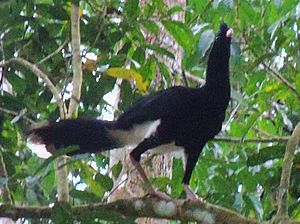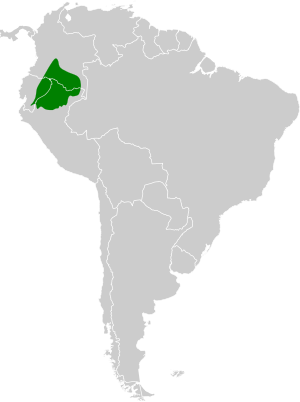Salvin's curassow facts for kids
Quick facts for kids Salvin's curassow |
|
|---|---|
 |
|
| Conservation status | |
| Scientific classification | |
| Genus: |
Mitu
|
| Species: |
salvini
|
 |
|
| Synonyms | |
|
Crax salvini (Reinhardt, 1879) |
|
The Salvin's curassow (Mitu salvini) is a type of bird. It belongs to the family Cracidae. This family includes birds like chachalacas, guans, and other curassows. You can find this bird in Colombia, Ecuador, and Peru.
Contents
About the Salvin's Curassow
For a while, scientists thought the Salvin's curassow belonged to a different group of birds. But new studies of its genes showed it is part of the Mitu group. This bird is unique and does not have different subspecies.
What Does a Salvin's Curassow Look Like?
Salvin's curassows are fairly large birds. They are about 75 to 89 cm (2.5 to 2.9 ft) long. That's about the length of a baseball bat! They weigh around 3,100 g (6.8 lb), which is more than a big bag of sugar. Most of their feathers are black. They have a white belly and white tips on their tail feathers.
Where Do Salvin's Curassows Live?
You can find Salvin's curassows in South America. They live east of the Andes Mountains. Their home includes southern Colombia, eastern Ecuador, and northern Peru.
These birds like to live in wet forests. They prefer "terra firme" forests, which are high and dry, especially when the rainy season starts. They also live in "várzea" forests, which are flooded for part of the year. They really like old, untouched forests. You can find them up to about 400 m (1,300 ft) high in Ecuador. In Colombia, they live up to 600 m (2,000 ft) high. Long ago, they were found even higher, up to 900 m (3,000 ft).
How Salvin's Curassows Behave
Movement and Territory
Salvin's curassows usually stay in one place. They don't move around much. However, a pair of birds might move their home area a little bit. This happens if they need to find more food during different times of the year.
What Salvin's Curassows Eat
These birds look for food mostly on the ground. They can be seen alone, in pairs, or in small family groups. Their diet is mostly fruits, making up about 70% of what they eat. They also eat seeds (10%). The rest of their diet (20%) includes flowers, leaves, small bugs, and other things. They even swallow sand and small stones. This helps them digest their food. Sometimes, they have been seen eating leftover animal parts.
Reproduction and Life Cycle
Salvin's curassow pairs seem to stay together all year. They don't usually fight over their territory. In Colombia, the nesting season is from January to May or June. The male bird builds several nests. The female then chooses one of these nests. She usually lays two eggs.
Sounds and Calls
The male Salvin's curassow has a deep "booming" song. It sounds like "mmm mmmMMMM ... BMM’mmmm-mmmm". He sings mostly in the morning and at night. The female also sings, but her voice is a bit rougher. They have other calls too. An alarm call sounds like "pieew, pieew". When they feel threatened, they make a "goorh, goorh" sound. For staying in touch, they use a "coh coh" call.
Conservation Status
The IUCN (International Union for Conservation of Nature) has looked at the Salvin's curassow. They have listed it as a species of "Least Concern." This means it is not currently in danger of disappearing. However, hunting is the biggest threat to these birds. They are rare near towns and cities. But in places that are harder to reach, they are still quite common.
See also
 In Spanish: Pavón nagüiblanco para niños
In Spanish: Pavón nagüiblanco para niños


